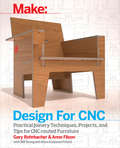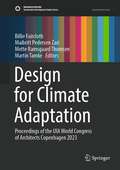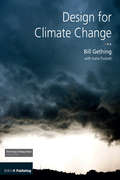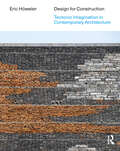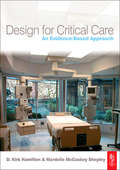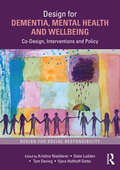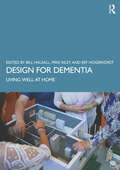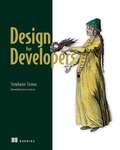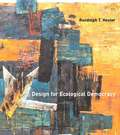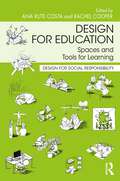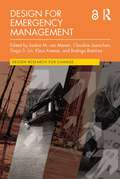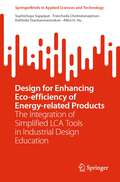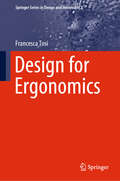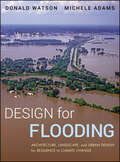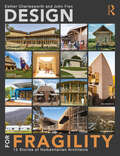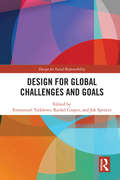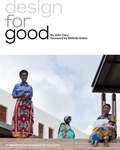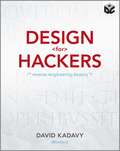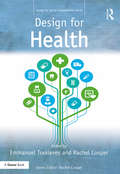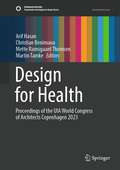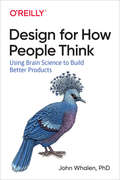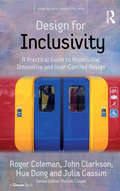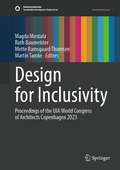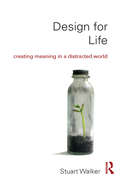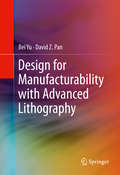- Table View
- List View
Design for CNC: Furniture Projects and Fabrication Technique
by Anna Kaziunas France Bill Young Gary Rohrbacher Anne FilsonDesign, DIY, and computer-controlled fabrication are a powerful combination for making high-quality customized things. Written by the founders of the architecture, design, and research firm Filson and Rohrbacher, this book takes you through the basics of CNC fabrication, the design process, production, and construction of your own furniture designs. Through their AtFAB series of projects, accompanied by an overview of digital techniques and design thinking, this book introduces the knowledge and skills that you'll find widely applicable across all kinds of CNC projects. Not only will you learn how to design, fabricate, and assemble a wide range of projects, you'll have some great furniture to show for it! While 3D printing has been grabbing headlines, high school, college, library, and other public makerspaces have been making things with CNC machines. With a CNC router, you can cut parts from strong, tactile, durable materials like wood. Once you have your design and material, you can set up your job and let it run. When it's done, you can put the project together for an heirloom of your own. While 3D printing can make exciting things with complex designs, CNCs are the digital workhorses that produce large-scale, long-lasting objects.
Design for Climate Adaptation: Proceedings of the UIA World Congress of Architects Copenhagen 2023 (Sustainable Development Goals Series)
by Mette Ramsgaard Thomsen Martin Tamke Billie Faircloth Maibritt Pedersen ZariThe book provides new perspectives from leading researchers accentuating and examining the central role of the built environment in conceiving and implementing multifaceted solutions for the complex challenges of climate change, revealing critical potentials for architecture and design to contribute in more informed and long-term ways to the urgent transition of our society. The book offers a compilation of peer-reviewed papers that uniquely connects knowledge broadly across practice and academia, from the newest technologies and methods to indigenous knowledge, community engagement, techniques for ecosystem regeneration, nature-based solutions, and more. The book is part of a series of six volumes that explore the agency of the built environment in relation to the SDGs through new research conducted by leading researchers. The series is led by editors Mette Ramsgaard Thomsen and Martin Tamke in collaboration with the theme editors: - Design for Climate Adaptation: Billie Faircloth and Maibritt Pedersen Zari- Design for Rethinking Resources: Carlo Ratti and Mette Ramsgaard Thomsen (Eds.)- Design for Resilient Communities: Anna Rubbo and Juan Du (Eds.)- Design for Health: Arif Hasan and Christian Benimana (Eds.)- Design for Inclusivity: Magda Mostafa and Ruth Baumeister (Eds.)- Design for Partnerships for Change: Sandi Hilal and Merve Bedir (Eds.)
Design for Climate Change
by Katie Puckett William GetheringFord architects, contractors, engineers and specialists in the field, this book uses real-world evidence from a Technology Strategy Board-funded research project to develop a set of tools for architects and other building designers to meet a growing need to anticipate future climate change. Built on in his seminal future climate change report for the TSB, identifies three broad categories of climate change impacts on building design – comfort and energy performance, construction, and managing water.
Design for Construction: Tectonic Imagination in Contemporary Architecture
by Eric HöwelerArguing that a gulf exists between design and construction, between conceptual thinking and the constructed building, this book explores projects and practices that span the gap by thinking through materials and processes with what Höweler calls a tectonic imagination.Design for Construction is organized into 10 chapters covering topics such as means and methods, part-to-whole relationships, material research, digital design workflows, risk mitigation, construction sequencing, digital fabrication, ethical material sourcing, and circular construction practices. Höweler provides a careful analysis of over 200 buildings projects by practices including Amateur Architecture Studio, Barkow Leibinger, Diller Scofidio + Renfro, Ensamble, GLUCK+, Herzog & de Meuron, Johnston Marklee, MASS Design, NADAAA, Neri&Hu, OMA, and SANAA.Re-engagement of design and building is a means of reclaiming agency for architects as the discipline grapples with difficult questions of climate change, material scarcity, social impact, and how designers can play a more meaningful role in shaping the built environment at this moment with an eye toward the future. This book will be crucial reading for both architects and students of architecture.
Design for Critical Care: An Evidence-Based Approach
by Mardelle McCuskey Shepley D. Kirk HamiltonIt is now widely recognized that the physical environment has an impact on the physiology,psychology, and sociology of those who experience it. When designing a critical care unit,the demands on the architect or designer working together with the interdisciplinary teamof clinicians are highly specialized. Good design can have a hugely positive impact in termsof the recovery of patients and their hospital experience as a whole. Good design can alsocontribute to productivity and quality of the work experience for the staff. 'Design for Critical Care' presents a thorough and insightful guide to the very best practicein intensive care design, focusing on design that has been successful and benefi cial to bothhospital staff and hospital patients. By making the connection between research evidence anddesign practice, Hamilton and Shepley present an holistic approach that outlines the future forsuccessful design for critical care settings.
Design for Dementia, Mental Health and Wellbeing: Co-Design, Interventions and Policy (Design for Social Responsibility)
by Kristina Niedderer, Geke Ludden, Tom Dening and Vjera Holthoff-DettoThis edited volume offers the first overview and reflective discussion of how design can contribute to people’s wellbeing and mental health in the context of dementia, mental illness and neurodiversity. This book explores and promotes holistic, salutogenic and preventive strategies that recognise and respond to people’s needs, wants, wishes and rights to further health, wellbeing and equality. Bringing together years of experience as designers and clinicians, the contributors to the book emphasise how design can be a collaborative, creative process as well as an outcome of this process, and they reveal how this is guided by mental health and design policy. Through its three parts, the book explores themes of ethics, citizenship and power relationships in co-design, providing an overview of current developments and approaches in co-design; of the culturally and value sensitive adaptation of design interventions and their applications, many of which are a result of co-design; and of policy and related standards in and for design and mental health. In this way, the book demonstrates how design can help to support people, their care partners and care professionals in promoting mental health and wellbeing, and it offers a rich resource on how to create a sustainable future for care in this domain. The book provides a unique and holistic overview and resource for designers, researchers, students, policy providers and health and care professionals to help support the development and adoption of person-centred design processes and interventions.
Design for Dementia: Living Well at Home
by Eef Hogervorst Michael Riley Bill HalsallDesign for Dementia is written by an interdisciplinary team of professionals and academics whose aim is to present lessons learnt from the Dementia Demonstration House at the Building Research Establishment’s Innovation Park. Known as Chris and Sally’s House, the project represents a unique opportunity to show in practice what can be done to assist people living with dementia to continue to live at home and as part of the community with as much independence as possible. This book presents evidence based practical design guidance backed up by over 15 combined years of research by experienced professional designers.Beginning with an introduction which provides the background to the global dementia epidemic to allow readers to gain a better understanding of the issues they must consider, the book then discusses how good design principles, planning and construction standards can be used to effectively respond to the dementia crisis. The detailed findings from research using Chris and Sally’s House are presented and discussed, along with practical examples and success stories ranging from simple design features to the more complex use of sensors and automated ventilation.The hope is that readers can apply the lessons learnt from Chris and Sally’s House to successfully integrate solutions into the design of new or refurbished housing for the elderly and also that the tools and insights shared will inform the wider context of good housing design, as well as the spectrum of constraints and design standards which often apply. This book is important reading for architects, designers, engineers and project managers, but also anyone with an interest in learning about practical solutions to aid those with dementia to live well at home.
Design for Developers
by Stephanie StimacSolve common application design and usability issues with flair! These essential design and UX techniques will help you create good user experiences, iterate smoothly on frontend features, and collaborate effectively with designer colleagues.In Design for Developers you will learn how to: Use color, typography, and layout to create hierarchy on a web page Apply color palettes consistently in a user interface Choose the correct typefaces and fonts Conduct user research to validate design decisions Quickly plan a website&’s layout and structure In Design for Developers, author Stephanie Stimac shares the unique insights she&’s learned as a designer on the Microsoft Developer Experiences team. This one-of-a-kind book provides a developer-centric approach to the essential design fundamentals of modern web applications. You&’ll learn how to craft a polished visual design with just color, space, and typeface, and put all your new skills into practice to design a website from scratch. Foreword by Aaron Gustafson. About the technology Developer-made design decisions can have a real impact on a site&’s user experience. Learn to speak design&’s language, and you&’ll be able to confidently contribute to a design process, collaborate with designer colleagues, and make more informed decisions about how you build your apps. About the book Design for Developers reveals essential design and UX principles every web developer needs to know. You&’ll love the book&’s developer-centric approach, which demonstrates new ideas with examples from popular sites and user interfaces. Discover insightful techniques for user research, and learn to use color, typography, and layout to create communicative web visuals. By the time you&’re done reading, you&’ll know it&’s true: having good design sense will make you a better web developer! What's inside Conduct user research to validate design decisions Quickly plan a website&’s layout and structure Iterate smoothly on frontend features Use color, typography, and layout to create hierarchy on a web page About the reader For web developers familiar with HTML, CSS, and the JavaScript basics. About the author Stephanie Stimac is a design technologist and senior product manager who focuses on building and improving developer experiences. She has previously worked on the Microsoft Edge browser. Table of Contents PART 1 DESIGN BASICS 1 Bridging the gap between design and development 2 Design fundamentals PART 2 USER EXPERIENCE 3 User experience basics 4 User research 5 User experience design PART 3 VISUAL DESIGN ELEMENTS 6 Web layout and composition 7 Enhancing web layout with animation 8 Choosing and working with typography on the web 9 Color theory 10 Building a website PART 4 AFTER VISUAL DESIGN 11 Test, validate, iterate 12 Developer choices and user experience
Design for Ecological Democracy
by Randolph T. HesterShows how to combine the forces of ecological science and participatory democracy to design urban landscapes that enable us to act as communities, are resilient rather than imperiled, and touch our hearts. Over the last fifty years, the process of community building has been lost in the process of city building. City and suburban design divides us from others in our communities, destroys natural habitats, and fails to provide a joyful context for our lives. In Design for Ecological Democracy, Randolph Hester proposes a remedy for our urban anomie. He outlines new principles for urban design that will allow us to forge connections with our fellow citizens and our natural environment. He demonstrates these principles with abundantly illustrated examples -- drawn from forty years of design and planning practice -- showing how we can design cities that are ecologically resilient, that enhance community, and that give us pleasure. Hester argues that it is only by combining the powerful forces of ecology and democracy that the needed revolution in design will take place. Democracy bestows freedom; ecology creates responsible freedom by explaining our interconnectedness with all creatures. Hester's new design principles are founded on three fundamental issues that integrate democracy and ecology: enabling form, resilient form, and impelling form. Urban design must enable us to be communities rather than zoning-segregated enclaves and to function as informed democracies. A simple bench at a centrally located post office, for example, provides an opportunity for connection and shared experience. Cities must be ecologically resilient rather than ecologically imperiled, adaptable to the surrounding ecology rather than dependent on technological fixes. Resilient form turns increased urban density, for example, into an advantage. And cities should impel us by joy rather than compel us by fear; good cities enrich us rather than limit us. Design for Ecological Democracy is essential reading for designers, planners, environmentalists, community activists, and anyone else who wants to improve a local community.
Design for Education: Spaces and Tools for Learning (ISSN)
by Ana Rute CostaThis book charts the impact of design on education, specifically focusing on how design can shape the spaces and tools for learning.This edited collection brings together the work of designers, architects, engineers, professionals, educators, and researchers, and presents a series of case studies and research developed from across Europe, North America, South America, Africa, Australia, and Asia. The book provides the tools to develop innovative approaches to design for education, and illustrates the conversation and action required to foster socially responsible design for education. As the contributions show, we must look at education as an input and output of a complex system, and we need to adopt an interdisciplinary multiple stakeholder approach, bringing together experts from a range of different fields and backgrounds as a cohesive strategy to improve future learning and teaching environments.Providing guidance and a theoretical framework for designing spaces and tools for learning, this book will be a useful resource for design and architecture students, as well as practitioners, educational researchers, educational practitioners, policymakers, and behaviour and built environment researchers.
Design for Emergency Management (Design Research for Change)
by Rodrigo Ramírez Claudine Jaenichen Tingyi S. Lin Klaus Kremer Saskia M. van ManenThrough a combination of theory, practice, and a range of interdisciplinary case studies, this book expands how we define and think about the critical role and relationship between design and emergencies. This role extends far beyond aesthetics: the book highlights the urgency of ensuring that a wide range of stakeholders and a diverse representation of the public comes together to work towards preventing disasters. Design in the context of disasters, such as earthquakes, hurricanes, flooding and (wild) fires, provides new ways of looking at challenges. It contributes methods to actively engage communities in managing and minimizing disaster risk. Contributors present the latest research on how (collaborative) design and design thinking contribute to the development of processes and solutions to increase disaster literacy and decrease disaster risk for individuals and entire communities. Chapters highlight applied research and implementation of design and design thinking before, during, and after emergencies, resulting in a set of design guidelines derived from best practice. The book will be of interest to scholars and practitioners in emergency management, product and service design, strategic design, design research, co-design, social design, design for change, and human-centered design.
Design for Enhancing Eco-efficiency of Energy-related Products: The Integration of Simplified LCA Tools in Industrial Design Education (SpringerBriefs in Applied Sciences and Technology)
by Allen H. Hu Suphichaya Suppipat Treechada Chotiratanapinun Kulthida TeachavorasinskunThis brief textbook underpins the concept of eco-efficiency in product design and systematically addresses the essence of the integration of simplified life cycle assessment (LCA) methods and tools into industrial design. Fundamental steps of LCA-based tools implementation within the higher education context are proposed, using energy-related products (ErP) design as a prime case study. All chapters are designed to respond to the common frequently asked questions in LCA-based tools implementation during the sustainable product design process. The chapters are also enriched with discussions, data sources of simplified LCA tools, and examples of design assignments that provide constructive learning. Some assignments aim at encouraging tool users’ reflections while others tackle particularly at knowledge exchange. The examples can assist the reader to visualize challenges and opportunities to engage learners who are tool users. This textbook broadens LCA knowledge for industrial design and environmental engineering students as well as enhance their sustainable product design performance. For professional practitioners including industrial designers, product engineers, entrepreneurs and the like, this textbook can be used as a guide at the introductory level for integrating life cycle thinking into product design and development.
Design for Ergonomics (Springer Series in Design and Innovation #2)
by Francesca TosiThis book focuses on the global quality of the design of systems that people interact with during their work activities and daily lives; a quality that involves the globality of people’s experience – physical, sensory, cognitive and emotional. It presents a concise and structured overview of the ergonomic approach to planning, and of methodological and operational tools from ergonomic research that can more directly and concretely contribute to the design process. The book also explores physical ergonomics and cognitive ergonomics, which are essential components of design culture. The final section addresses the main design problems and intervention criteria regarding the design of environments, products and equipment, as well as the design of communication, training and learning interface systems based on digital technologies. The book is chiefly intended for designers and anyone interested in the methods, tools and opportunities for in-depth analysis and development that ergonomics can offer regarding the conception, production and testing of products, environments and services, whether physical or virtual. It also offers a learning resource for professionals and students in Industrial Design and Planning.
Design for Flooding
by Michele Adams Donald Watson"Design for Flooding contains considerable useful information for practitioners and students. Watson and Adams fill the void for new thinking. . . and they advance our ability to create more sustainable, regenerative, and resilient places. " --Landscape Architecture Magazine
Design for Fragility: 13 Stories of Humanitarian Architects
by Esther Charlesworth John FienThe demand is now urgent for architects to respond to the design and planning challenges of rebuilding cities and landscapes being destroyed by civil conflict, (un)natural disasters, political instability, and poverty. The number of people fleeing their homes and being displaced by such conflict now totals almost 100 million. Despite the massive human and physical costs of these crises, the number of architects, planners, and landscape architects equipped to work with disaster and development professionals in rebuilding in the aftermath of conflict, floods, fires, earthquakes, typhoons, and tsunamis remains chronically low. Design for Fragility expands the nascent, but rapidly growing field of humanitarian architecture by exploring 13 design responses to such conflict and displacement across 11 countries, including Australia, Bangladesh, Fiji, India, Iran, Pakistan, and the USA. Linked to this displacement is the systemic poverty that often lingers from previous colonial territories and eras, in which many of the featured projects in the book are located. This book follows Charlesworth’s Humanitarian Architecture: 15 Stories of Architects Working After Disasters (Routledge 2014), which analysed the role for architects in exercising ‘spatial agency’ while designing shelter and settlement projects for communities after conflict and disaster. Since that time, the humanitarian architecture movement has expanded globally with the prominence of design agencies including the MASS Design Group and Architecture Sans Frontières (ASF) International. Design for Fragility analyses this role of spatial agency in architecture by addressing diverse conditions of fragility across 13 built projects – from refugee housing in Uganda and an orphanage for teenage girls in Iran to a residential centre in Northern Australia for people with acquired brain injury. Each of the projects profiled in this book explore: The experiences and perceptions of fragility – or precarity – that provided a design challenge and directed the particular spatial response. The specific typology of the project, whether that be a housing, health, children’s, or a First Nations project. The personal values that influenced the architects to work on humanitarian/community projects and how consultation occurred with diverse and often contested project stakeholders. The experiences of the design team as well as project managers, occupants, and donors of the built project, exploring what they deemed successful about the project, and what, if any, were its limitations. Beautifully designed with over 150 illustrations, this practical and inspiring book is for architects, landscape architects, design educators, humanitarian and development aid agencies that are involved, or seeking to be part, of future disaster mitigation and reconstruction strategies and projects, globally.
Design for Global Challenges and Goals (Design for Social Responsibility)
by Emmanuel Tsekleves; Rachel Cooper; Jak SpencerDesign for Global Challenges and Goals charts the developments, opportunities and challenges for design research in addressing global challenges facing developing contexts focusing on the UN’s Sustainable Development Goals. The book explores the role that design and social responsibility play in the UN Sustainable Development Goals and how design works in developing contexts. It presents 10 design-led case studies addressing different Sustainable Development Goals ranging from reducing poverty and hunger, improving health and wellbeing, promoting gender equality, developing more sustainable cities and communities, encouraging more responsible consumption and production, and tackling climate change. Design for Global Challenges and Goals also addresses the future, offering foresight into the research in global challenges by identifying the opportunities and emerging trends for researchers. Providing a guide to the state of the art of design research that addresses the Sustainable Development Goals, this book will be of interest to researchers, practitioners and students who want their research to address global challenges.
Design for Good: A New Era of Architecture for Everyone
by John Cary"That's what we do really: we do miracles,” said Anne-Marie Nyiranshimiyimana, who learned masonry in helping to build the Butaro Hospital, a project designed for and with the people of Rwanda using local materials. This, and other projects designed with dignity, show the power of good design. Almost nothing influences the quality of our lives more than the design of our homes, our schools, our workplaces, and our public spaces. Yet, design is often taken for granted and people don't realize that they deserve better, or that better is even possible.In Design for Good, John Cary offers character-driven, real-world stories about projects around the globe that offer more—buildings that are designed and created with and for the people who will use them. The book reveals a new understanding of the ways that design shapes our lives and gives professionals and interested citizens the tools to seek out and demand designs that dignify.For too long, design has been seen as a luxury, the province of the rich, not the poor. That can no longer be acceptable to those of us in the design fields, nor to those affected by design that doesn't consider human aspects.From the Mulan Primary School in Guangdong, China to Kalamazoo College's Arcus Center for Social Justice Leadership, the examples in the book show what is possible when design is a collaborative, dignified, empathic process. Building on a powerful foreword by philanthropist Melinda Gates, Cary draws from his own experience as well as dozens of interviews to show not only that everyone deserves good design, but how it can be achieved. This isn't just another book for and about designers. It's a book about the lives we lead, inextricably shaped by the spaces and places we inhabit.
Design for Hackers: Reverse Engineering Beauty
by David KadavyMany design books try to teach design through lists of "do's" and "don'ts." But hackers know you need a deeper understanding of something to really do it well. Design for Hackers takes apart design by "reverse-engineering" Impressionist painting, Renaissance sculpture, the Mac OS X Aqua interface, Twitter's web interface, and much more. You'll learn about color theory, typography, proportions, and design principles. This theoretical advice is mixed with concrete, actionable advice such as suggestions for color scheme tools, and a chart of "all of the fonts you'll ever need".
Design for Health
by Rachel Cooper Emmanuel TseklevesOne of the most complex global challenges is improving wellbeing and developing strategies for promoting health or preventing ‘illbeing’ of the population. The role of designers in indirectly supporting the promotion of healthy lifestyles or in their contribution to illbeing has emerged. This means designers now need to consider, both morally and ethically, how they can ensure that they ‘do no harm’ and that they might deliberately decide to promote healthy lifestyles and therefore prevent ill health. Design for Health illustrates the history of the development of design for health, the various design disciplines and domains to which design has contributed. Through 26 case studies presented in this book, the authors reveal a plethora of design research methodologies and research methods employed in design for health. The editors also present, following a thematic analysis of the book chapters, seven challenges and seven areas of opportunity that designers are called upon to address within the context of healthcare. Furthermore, five emergent trends in design in healthcare are presented and discussed. This book will be of interest to students of design as well as designers and those working to improve the quality of healthcare.
Design for Health: Proceedings of the UIA World Congress of Architects Copenhagen 2023 (Sustainable Development Goals Series)
by Mette Ramsgaard Thomsen Martin Tamke Arif Hasan Christian BenimanaThe book provides new perspectives from leading researchers accentuating and examining the central role of the built environment in conceiving and implementing multifaceted solutions to the complex challenges of physical and mental health, revealing critical potentials for architecture and design to contribute in more informed and long-term ways to the urgent transition of our society. The volume book offers a compilation of peer-reviewed papers that uniquely connects knowledge and criticality broadly across practice and academia; from new technologies, theories, and methods to community -engaged practice on many scales, and more. The book is part of a series of six volumes that explore the agency of the built environment in relation to the SDGs through new research conducted by leading researchers. The series is led by editors Mette Ramsgaard Thomsen and Martin Tamke in collaboration with the theme editors: - Design for Climate Adaptation: Billie Faircloth and Maibritt Pedersen Zari- Design for Rethinking Resources: Carlo Ratti and Mette Ramsgaard Thomsen (Eds.)- Design for Resilient Communities: Anna Rubbo and Juan Du (Eds.)- Design for Health: Arif Hasan and Christian Benimana (Eds.)- Design for Inclusivity: Magda Mostafa and Ruth Baumeister (Eds.)- Design for Partnerships for Change: Sandi Hilal and Merve Bedir (Eds.)
Design for How People Think: Using Brain Science to Build Better Products
by John WhalenUser experience doesn’t happen on a screen; it happens in the mind, and the experience is multidimensional and multisensory. This practical book will help you uncover critical insights about how your customers think so you can create products or services with an exceptional experience.Corporate leaders, marketers, product owners, and designers will learn how cognitive processes from different brain regions form what we perceive as a singular experience. Author John Whalen shows you how anyone on your team can conduct "contextual interviews" to unlock insights. You’ll then learn how to apply that knowledge to design brilliant experiences for your customers.Learn about the "six minds" of user experience and how each contributes to the perception of a singular experienceFind out how your team—without any specialized training in psychology—can uncover critical insights about your customers’ conscious and unconscious processesLearn how to immediately apply what you’ve learned to improve your products and servicesExplore practical examples of how the Fortune 100 used this system to build highly successful experiences
Design for Inclusivity: A Practical Guide to Accessible, Innovative and User-Centred Design (Design for Social Responsibility)
by John Clarkson Roger Coleman Julia CassimInclusive design not only ensures that products, services, interfaces and environments are easier to use for those with special needs or limitations, but in doing so also makes them better for everyone. Design for Inclusivity, written by a team that has pioneered inclusive design practice internationally, reviews the recent social trends and pressures that have pushed this subject to the fore, and assesses design responses to date in an international context. The authors make the business case for inclusive design and explain the formalisation of the approach in standards and legislation. The text includes case studies which describe transport, product development, IT and service projects, as well as industry-university collaborative projects, and highlights lessons that have been learned. This is very much a practical book. It offers tools, techniques, guidelines and signposts for the reader to key resources, as well as including advice on research methods, and working with users and industry partners.
Design for Inclusivity: Proceedings of the UIA World Congress of Architects Copenhagen 2023 (Sustainable Development Goals Series)
by Mette Ramsgaard Thomsen Martin Tamke Magda Mostafa Ruth BaumeisterThe book provides new perspectives from leading experts examining the role of architects and urbanists in designing for inclusivity in our built environment. By focusing on themes of gender, race and ethnicity, ability, neurodiversity, age, poverty and socio-economy and the non-human, the book tackles the complex challenges that designers and scholars encounter and need to address in their works. The volume offers a diverse compilation of peer-reviewed papers related to architecture for inclusivity in various different formats, ranging from visual essays, argumentative papers and scholastic texts. It presents the notion of "availability", a concept which works to challenge the "othering" inherent in notions of inclusion and accessibility. In its introduction it presents a critical discourse around the challenges and potentials lying in the design for availability targeted towards a systemic change of our societies. The book is part of a series of six volumes that explore the agency of the built environment in relation to the SDGs through new research conducted by leading researchers. The series is led by editors Mette Ramsgaard Thomsen and Martin Tamke in collaboration with the theme editors: - Design for Climate Adaptation: Billie Faircloth and Maibritt Pedersen Zari - Design for Rethinking Resources: Carlo Ratti and Mette Ramsgaard Thomsen (Eds.) - Design for Resilient Communities: Anna Rubbo and Juan Du (Eds.) - Design for Health: Arif Hasan and Christian Benimana (Eds.) - Design for Inclusivity: Magda Mostafa and Ruth Baumeister (Eds.) - Design for Partnerships for Change: Sandi Hilal and Merve Bedir (Eds.)
Design for Life: Creating Meaning in a Distracted World
by Stuart WalkerStuart Walker’s design work has been described as life-changing, inspiring, disturbing and ferocious. Drawing on an extraordinarily diverse range of sources and informed by creative practice, Design for Life penetrates to the heart of modern culture and the malaise that underlies today’s moral and environmental crises. The author argues that this malaise is deep-seated and fundamental to the modern outlook. He shows how our preoccupation with technological progress, growth and the future has produced a constricted view of life – one that is both destructive and self-reinforcing. Based on over twenty-five years of scholarship and creative practice, he demonstrates the vital importance of solitude, contemplation, inner growth and the present moment in developing a different course – one that looks squarely at our current, precarious situation while offering a positive, hopeful way forward – a way that is compassionate, context-based, human scale, ethically motivated and critically creative. Design for Life is an intensely original contribution that will be essential reading for design practitioners and students. Written in a clear, accessible style, it will also appeal to a broader readership, especially anyone who is concerned with contemporary society’s rising inequalities and environmental failings and is looking for a more constructive, balanced and thoughtful direction.
Design for Manufacturability with Advanced Lithography
by Bei Yu David Z. PanThis book introduces readers to the most advanced research results on Design for Manufacturability (DFM) with multiple patterning lithography (MPL) and electron beam lithography (EBL). The authors describe in detail a set of algorithms/methodologies to resolve issues in modern design for manufacturability problems with advanced lithography. Unlike books that discuss DFM from the product level or physical manufacturing level, this book describes DFM solutions from a circuit design level, such that most of the critical problems can be formulated and solved through combinatorial algorithms.
